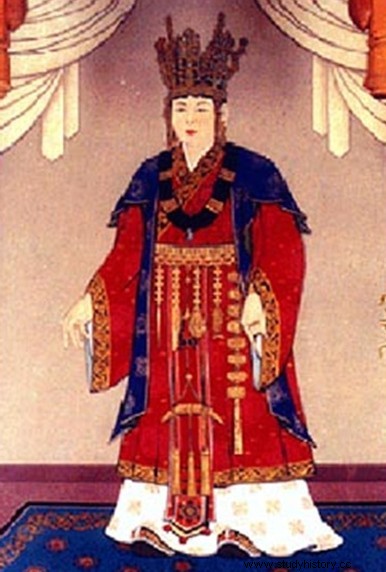Queen Seondeok (hangul:선덕여왕) ruled the Silla Kingdom, one of the three historical kingdoms of Korea, in the 7th century. Twenty-seventh sovereign of the kingdom, she is its first queen. During her reign, she encouraged arts and culture.
The Estate
Princess Deokman, first or second of King Jinpyeong's three daughters, was born in Korea in the 7th century when the peninsula was separated into three kingdoms:Koguryo, Paekche and Silla. Her father, king of Silla, has no male heir and appoints his daughter Deokman to succeed him to the throne, in her capacity as eldest or for her keen intelligence. The kingdom has never had a queen, but several women have already exercised power as councillors, dowager queens or regents and the status of women is relatively high although their role remains discriminated against.
A smart queen
 In 632, Princess Deokman became sole ruler of Silla as Seondeok. Her reign begins in violence, when she has to face a revolt and fights with the neighboring kingdom of Paekche. Seondeok rules with intelligence and strives to forge alliances to protect his kingdom. When Paekche invades Silla, she makes an alliance with the kingdom of Koguryo. When the latter turns against her, she strengthens her ties with the Chinese empire. Patron of arts and culture, Seondeok works to keep her kingdom together and reduce poverty.
In 632, Princess Deokman became sole ruler of Silla as Seondeok. Her reign begins in violence, when she has to face a revolt and fights with the neighboring kingdom of Paekche. Seondeok rules with intelligence and strives to forge alliances to protect his kingdom. When Paekche invades Silla, she makes an alliance with the kingdom of Koguryo. When the latter turns against her, she strengthens her ties with the Chinese empire. Patron of arts and culture, Seondeok works to keep her kingdom together and reduce poverty.
Like Empress Wu Zetian in China, Seondeok de Silla turned to Buddhism and encouraged the establishment of temples; in particular, she built the nine-storey temple of Hwangnyongsa (“temple of the golden dragon”), which was destroyed in the 13th century. She also built the Bunhwangsa temple and the Cheomseongdae, “the tower from which we observe the stars”, the oldest observatory in East Asia and one of the oldest scientific facilities in the world.
Bidam's revolt
In 647, Bidam, one of Seondeok de Silla's advisers, sparked a revolt against the queen, arguing that the kingdom could not be ruled by a woman. The Samguk sagi , historical chronicle of Korea, says that during the revolt, a star would have “fallen”. Bidam reportedly used it as a sign of the end of Seondeok's rule. In response, the Queen is said to have flown a flaming kite to demonstrate that the star had "come back to its place".
Seondeok dies during the revolt and his cousin, Jindeok, succeeds him. Subsequently, the revolt is defeated. Biram and 30 of his men are executed by order of the new queen. Jindeok will reign until 654.
